Getting the opportunity to write this review is truly a privilege. Apple Craft, Metal body, brand new Thompson ! So let’s get on with it:
1. IntroThe Thompson Submachinegun was developed by General John T. Thompson who envisioned a "one-man, hand-held machine gun" in .45 ACP as a "trench broom" for use in the ongoing trench warfare of World War I. The project was then titled "Annihilator I" and by 1918, most of the design issues had been resolved. However, the war ended two days before prototypes could be shipped to Europe. Thompson intended the weapon as an automatic "trench-broom" to sweep enemy troops from the trenches, filling a role for which the Browning Automatic Rifle (BAR) had been proven ill-suited. This concept had already been developed by German troops using their own Bergmann MP18, the world's first submachine gun, later officially renamed the "Thompson Submachine Gun."
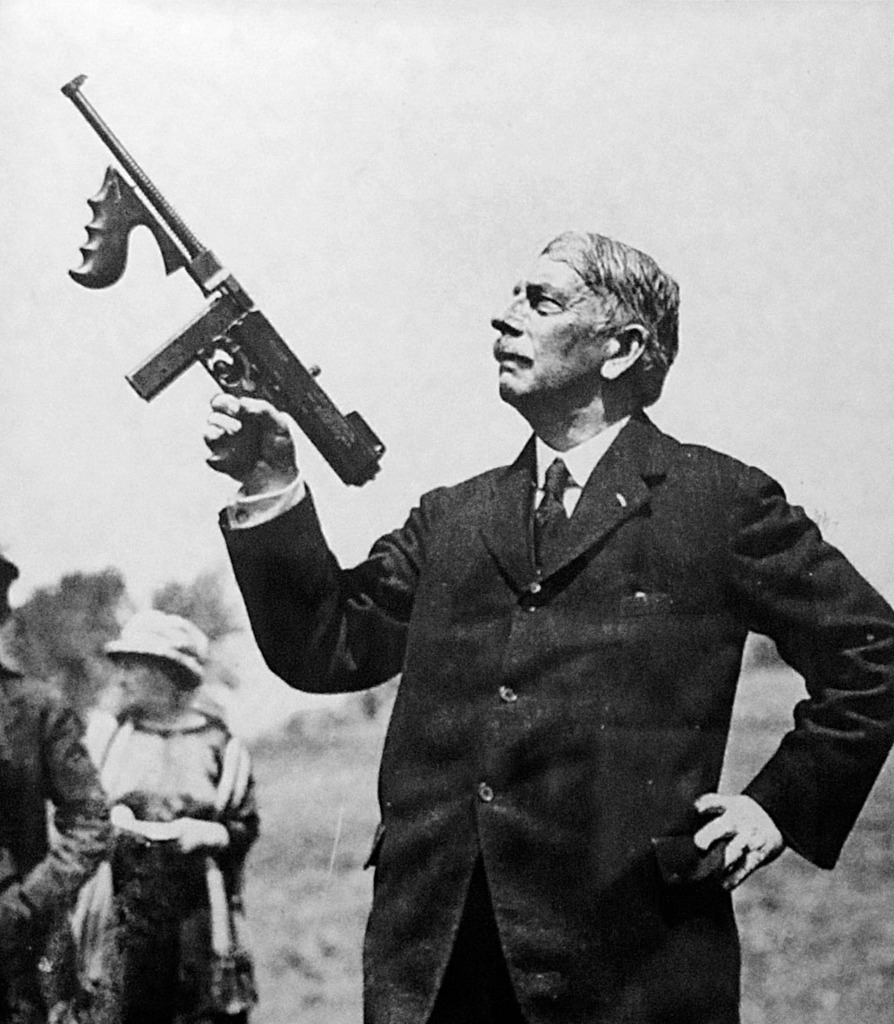
Early versions of the Thompson had a fairly high cyclic rate of fire, as high as 1,200 rounds per minute (rpm), most police Model 1921 at 850 rpm and military Model 1928 at 720 rpm later M1 and M1A1 Thompsons at 600 rpm. This rate of fire, combined with a rather heavy trigger pull and a stock with an excessive drop, increases the tendency for the barrel to climb off target in automatic fire. Compared to modern 9mm submachine guns, the .45 Thompson is quite heavy—weighing roughly the same as the M1 Garand semi-automatic rifle and it's hard to maintain because it requires lots of cleaning.
The select fire (semi- or full automatic) Thompson fires from the "open bolt" position, in which the bolt is held fully to rearward by the sear when cocked. When the trigger is depressed, the bolt is released, traveling forward to chamber and simultaneously fire the first and subsequent rounds until either the trigger is released or the ammunition is exhausted. This eliminates the risk of "cook-off", which can sometimes occur in closed-bolt automatic weapons when the barrel becomes so hot that chambered rounds auto-ignite, causing the weapon to fire uncontrollably.
Drum and box magazines.
Although the drum magazine provided significant firepower, in military service it was found to be overly heavy and bulky, especially when slung on patrol or on the march. Military users of the M1928A1 had complaints about the "L" fifty-round drum magazine; the British Army officially criticized "their excessive weight, the rattling sound they made...." and shipped thousands back to the U.S. in exchange for box magazines. The Thompson had to be cocked, bolt retracted ready to fire, to attach the drum. It attached and detached by sliding sideways, which made magazine changes slow and also created difficulty in clearing a cartridge malfunction ("jam").
In contrast, the "XX" twenty-round box magazine was light and compact, it tended not to rattle, and could be inserted with the bolt safely closed. It was quickly attached and detached, and was removed downward, making clearing jams easier. The box tripped the bolt open lock when empty, facilitating magazine changes. An empty box was easily reloaded with loose rounds. However, users complained it was limited in capacity. In the field, users frequently taped two "XX" magazines together to speed magazine changes.
Two alternatives to the "L" drum and "XX" box magazines were tested December 6, 1941, at Fort Knox: an extended thirty-round box magazine and a forty-round magazine made by welding two 20-round magazines face to face, jungle style. The 30-round box was approved as standard in December 1941 to replace the "XX" and "L" magazines.
The Thompson was one of the earliest submachine guns to incorporate a double-column, double-feed box magazine design, which undoubtedly contributed to the gun's reputation for reliability. In addition, the gun performed better than most after exposure to rain, dirt, and mud.
The Thompson first entered production as the M1921. It was available to civilians, although poor sales resulted from the expense of the weapon: the Thompson gun, with one Type XX 20 shot "stick" magazine, was priced at $200.00 in 1921 (at that time, a Ford automobile sold for $400.00). M1921 Thompsons were sold in small quantities to the United States Postal Inspection Service and to the United States Marine Corps. Federal sales were followed by sales to several police departments in the US and minor international sales to various armies and constabulary forces, chiefly in Central and South America. The Marines used their Thompsons in the Banana Wars and in China. Some of the first batches of Thompsons were bought in America by agents of the Irish Republic, notably Harry Boland. The Thompson achieved most of its early notoriety in the hands of Prohibition and Depression-era gangsters, motorized bandits and the lawmen who pursued them, and in Hollywood films about their exploits, most notably in the St Valentine's Day Massacre. It has been referred to by one researcher as the "gun that made the twenties roar." In 1926, the Cutt’s Compensator (a recoil brake) was offered as an option for the M1921; Thompsons with the compensator were cataloged as No. 21AC at the original price of $200.00, with the plain M1921 designated No. 21A at a reduced price of $175.00.In 1928, Federal Laboratories took over distribution of the weapon from Thompson's Auto Ordnance Corporation. The cost at this time was US$225 per weapon, with $5 per 50-round drum and $3 for 20-round magazine. Nationalist China acquired a quantity for use against Japanese land forces, and eventually began producing copies of the Thompson in small quantities for use by its armies and militias.
The Federal Bureau of Investigation first acquired Thompsons in 1933 following the Kansas City Massacre.
The Thompson was used in World War II in the hands of Allied troops as a weapon for scouts, non-commissioned officers (corporal, sergeant, and higher), and patrol leaders, as well as commissioned officers, tank crewmen, and soldiers performing raids on German positions. In the European theater, the gun was widely utilized in British and Canadian commando units, as well as in the U.S. Army paratrooper and Ranger battalions, where it was issued more frequently than in line infantry units.
A Swedish variant of the M1928A1, the Kulsprutepistol m/40 (submachine gun, model 40), served in the Swedish Army between 1940 and 1951. Through Lend-Lease, the Soviet Union also received the Thompson, but due to a shortage of appropriate ammunition, its use was not widespread. In the Malayan Campaign, the Burma Campaign and the Pacific Theater, Lend-Lease issue Thompsons were used by the British Army, Indian Army, Australian Army infantry and other Commonwealth forces.
The Army introduced the U.S. M3 and M3A1 submachine guns in 1943 with plans to produce the latter in numbers sufficient to cancel future orders for the Thompson, while gradually withdrawing it from first-line service. However, due to unforeseen production delays and requests for modifications, the M3/M3A1 never replaced the Thompson, and purchases continued until February 1944. At the end of World War II, the Thompson, with a total wartime production of over 1.5 million, outnumbered the M3/M3A1 submachine guns in service by nearly three to one.
After the Second World War Thompson submachine guns were used by both sides during the 1948 Arab-Israeli war, and during the Greek Civil War.
By the time of the Korean War, the Thompson had seen much use by the U.S. and South Korean military, even though Thompson had been replaced as standard issue by the M3/M3A1. With huge numbers of guns available in army ordnance arsenals, the Thompson remained classed as Limited Standard or Substitute Standard long after the standardization of the M3/M3A1. Many Thompsons were distributed to Chinese armed forces as military aid before the fall of Chiang Kai-Shek's government to Mao Zedong's Communist forces in 1949 during the Chinese Civil War. During the Cuban Revolution, the Thompson submachine gun was used by some of Fidel Castro's guerrillas. In the conflict in Northern Ireland, known as 'The Troubles' (1969–1998), the Thompson was again used by the Irish Republican paramilitaries. According to historian Peter Hart, "The Thompson remained a key part of both the Official IRA and Provisional IRA arsenals until well into the 1970s when it was superseded by the m16 and the AK-47. The Thompson was also used by U.S. and overseas law enforcement and police forces, most prominently by the FBI. The FBI used Thompsons until they were declared obsolete and ordered destroyed in the early 1970s.
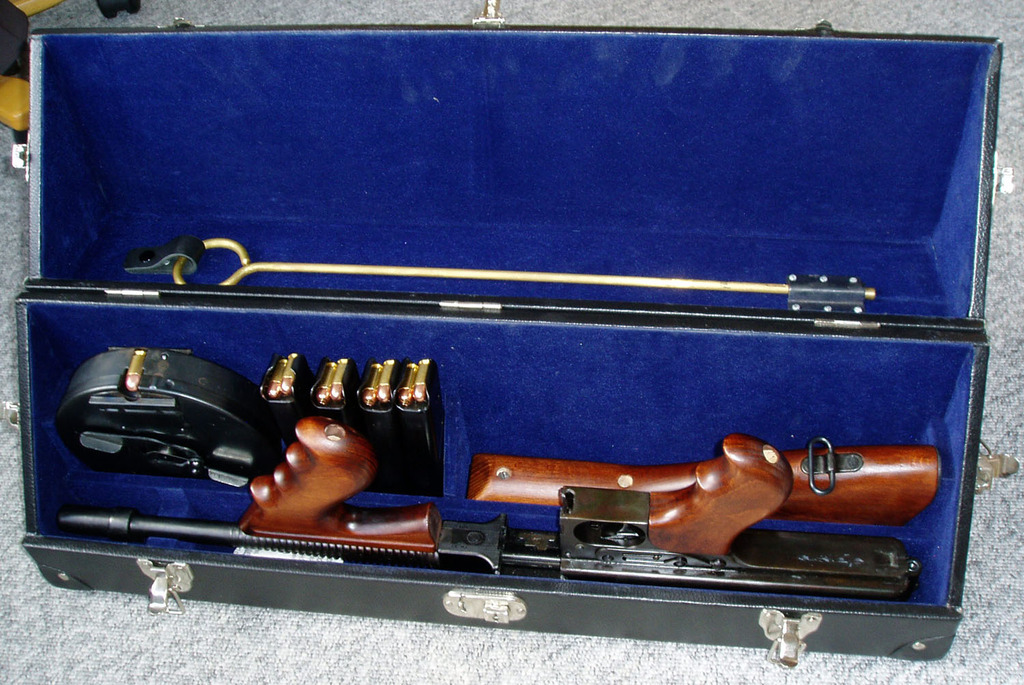
The M1928A1 variant entered mass production before the attack on Pearl Harbor, as on-hand stocks ran out. Changes included a horizontal fore end, in place of the distinctive vertical front grip ("pistol grip"), and a provision for a military sling. Despite new U.S. contracts for Lend-Lease shipments abroad to China, France, and the United Kingdom, as well as the needs of American armed forces, only two factories supplied M1928A1 Thompsons during the early years of World War II. Though it could use both the 50-round drum and the 20- or 30-round box magazines, active service showed the drums were more prone to jamming, rattled when moving, and were too heavy and bulky on long patrols. 562,511 were made. Wartime production variants had a fixed rear sight without the triangular sight guard wings and a non-ribbed barrel, both like those found on the M1/M1A1.
In addition, the Soviet Union received M1928A1s through Lend-Lease. The weapons were never issued to the Red Army because of a lack of .45 ACP ammunition on the Eastern Front; they were simply put in storage.
M1928M1A1 development
The staff of Savage Arms looked for ways to simplify the M1928A1, producing a prototype in Feb 1942 which was tested at Aberdeen Proving Ground in March 1942; Army Ordnance approved adoption as the M1 in April 1942. M1s were made by Savage Arms and by Auto-Ordnance. M1s were issued with the 30-round box magazine and would accept the earlier 20-round box, but would not accept the drum magazine. Responding to a request for further simplification, the M1 was standardized in April 1942 as the United States Submachine Gun, Cal. .45, M1. Rate of fire was reduced to approximately 600-700 rpm.
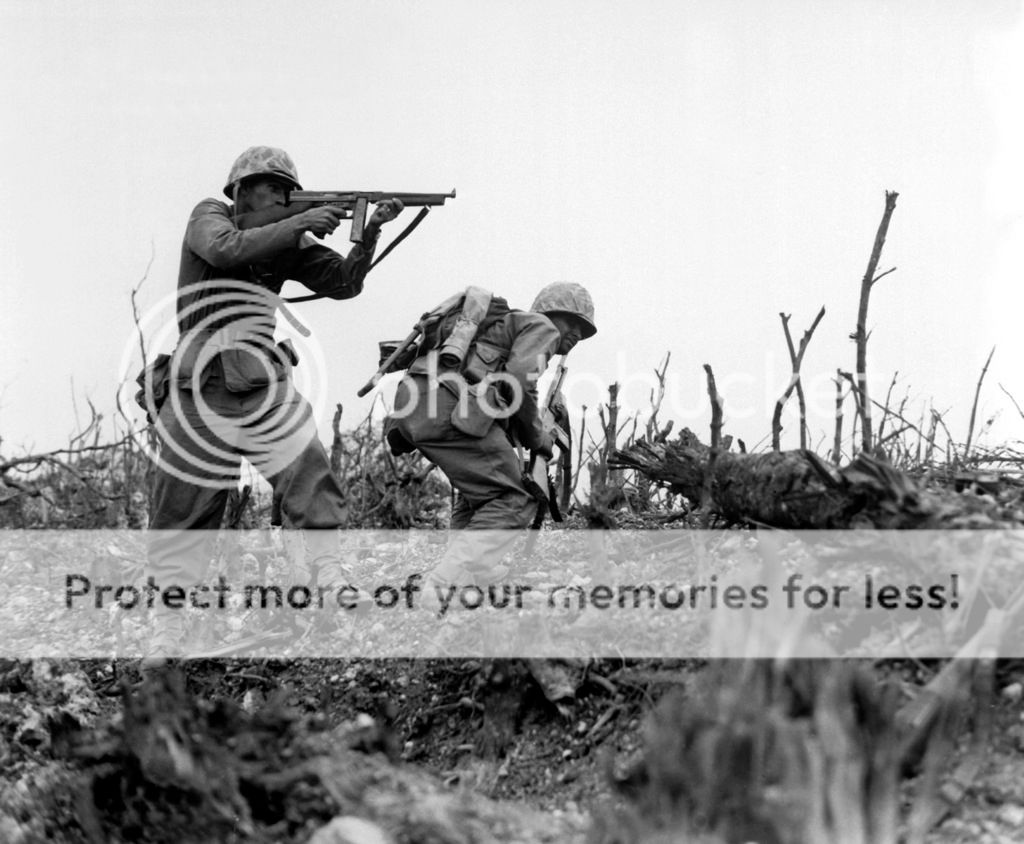
First issued in 1943, the M1 uses a simple blowback operation, with the charging handle moved to the side. The flip-up adjustable Lyman rear sight was replaced with a fixed L sight. Late M1s had triangular guard wings added to the rear L sight, which were standardized on the M1A1. The slots adjoining the magazine well allowing use of a drum magazine were removed. A new magazine catch with the provision for retaining drum magazines removed, was produced, but most M1s and later M1A1s retained the original. The less expensive and more-easily manufactured "stick" magazines were used exclusively in the M1, with a new 30-round version joining the familiar 20-round type. The Cutt’s compensator, barrel cooling fins, and Blish lock were omitted while the buttstock was permanently affixed. Late production M1 stocks were fitted with reinforcing bolts and washers to prevent splitting of the stock where it attached to the receiver. The British had used improvised bolts or wood screws to reinforce M1928 stocks. The M1 reinforcing bolt and washer were carried over to the M1A1 and retrofitted to many of the M1928A1s in U.S. and British service. Late M1s also had simplified fire control switches, also carried over to the M1A1. The M1A1, standardized in October 1942 as the United States Submachine Gun, Cal. .45, M1A1, could be produced in half the time of the M1928A1, and at a much lower cost. The main difference between the M1 and M1A1 was the bolt. The M1 bolt had a floating firing pin and hammer, the bolt of the M1A1 had the firing pin machined to the face of the bolt, eliminating unnecessary parts. The reinforced stock and protective sight wings were standard. The 30-round magazine became more common.
In 1939, Thompsons cost the government $209 apiece. By the spring of 1942, cost reduction design changes had brought this down to $70. In February 1944, the M1A1 reached a low price of $45 each, including accessories and spare parts, although the difference in price between the M1 and M1A1 was only $0.06. By the end of the war, the M1A1 was replaced with the even lower-cost M3 (commonly called the "Grease Gun").
2. Box and contentThe box is straight forward brown 2 piece card boardbox with a few dividers inside. Black print on the cardboard top and a label in 1 of the end faces. The divider allow some parts moving a bit, the one I looked at was filled with a bit of Japanese newspaper, eliminating parts skidding around.

Content of the box is as simple as the box top.
• Model gun body,
• stock, 2 screws for the stock,
• 30rd magazine,
• 1 bag of 5 cartridges and a loading tool, and
• 4 instruction sheets. (in Japanese).

So far I would say that what is needed is there, straight and simple.
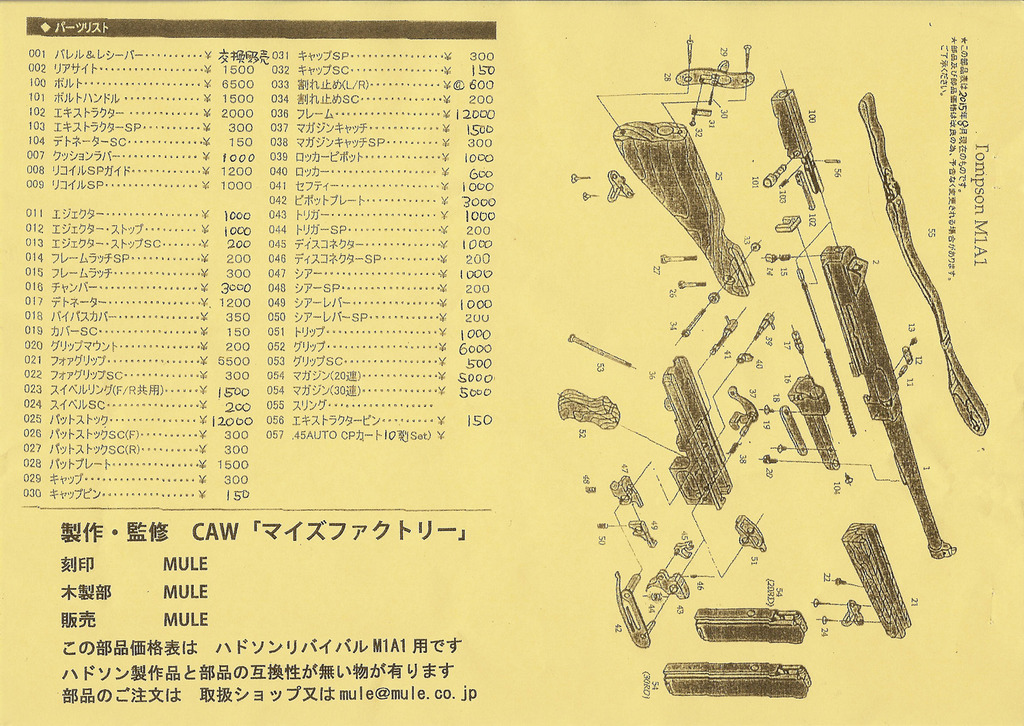
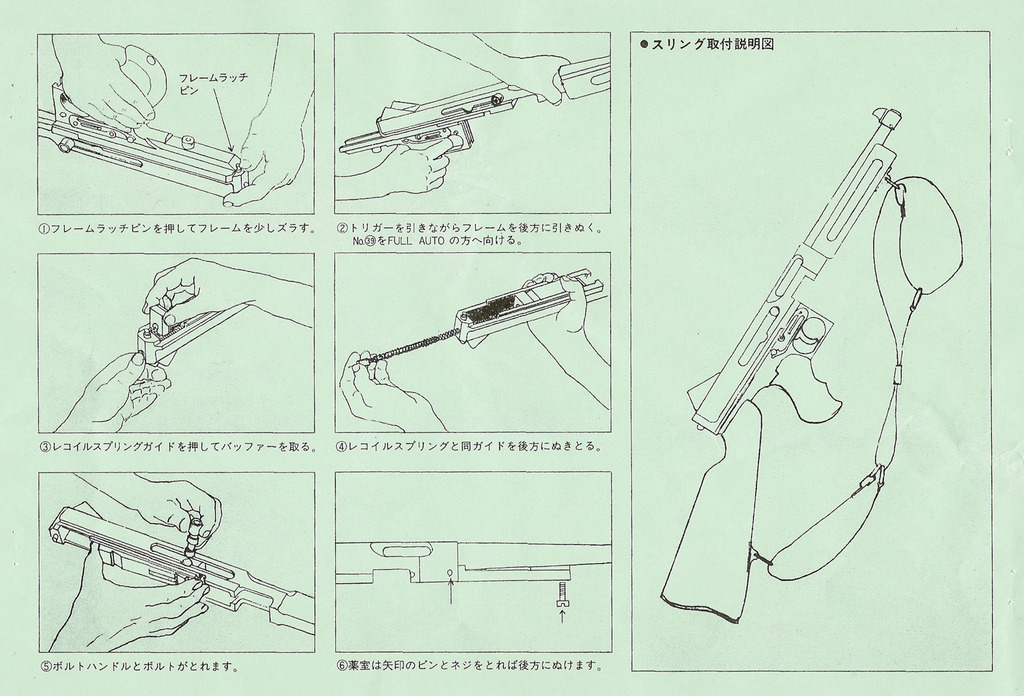
One important note here is that the model comes with the stock detached and the box does not have room for the fully assembled model gun. – I will return to this later.
3. LookFor the look of the box I guess it an individual matter, but I like this basic cardboard box and in my opinion this is very loyal to this WWII gun and the cost reduction philosophy behind the M1A1 version.
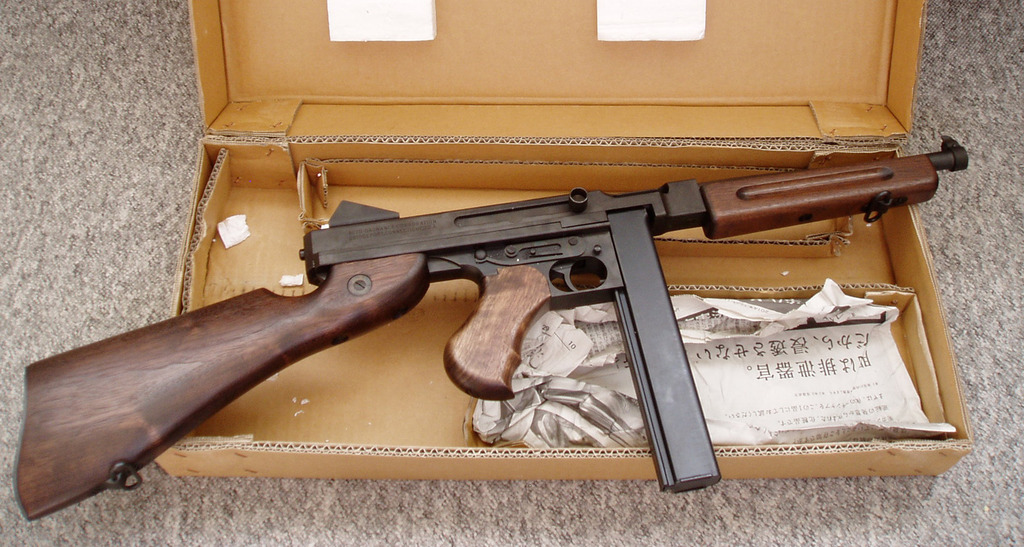
All metal parts are nice, dark, non-reflecting, as you might expect from a real gun. Use and lubrication will make some areas shiny, but that no different than for the real thing.
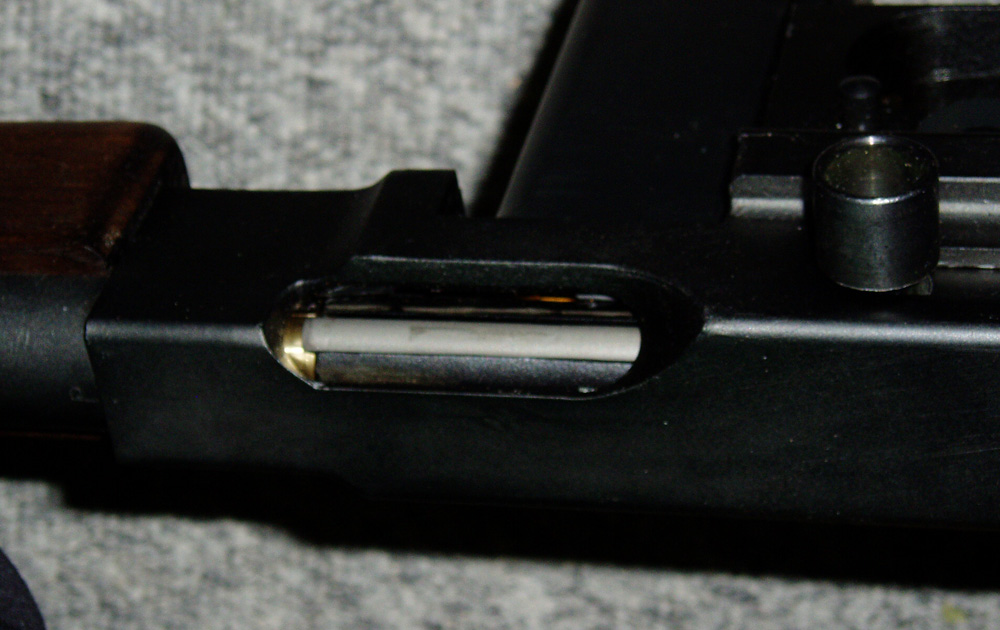
The wood work is absolutely nice. Actually I was thinking maybe a little too nice for a gun produced to be rushed into war – but NO ONE would ever complain it is a fine gun with fine real wood grips and stock.
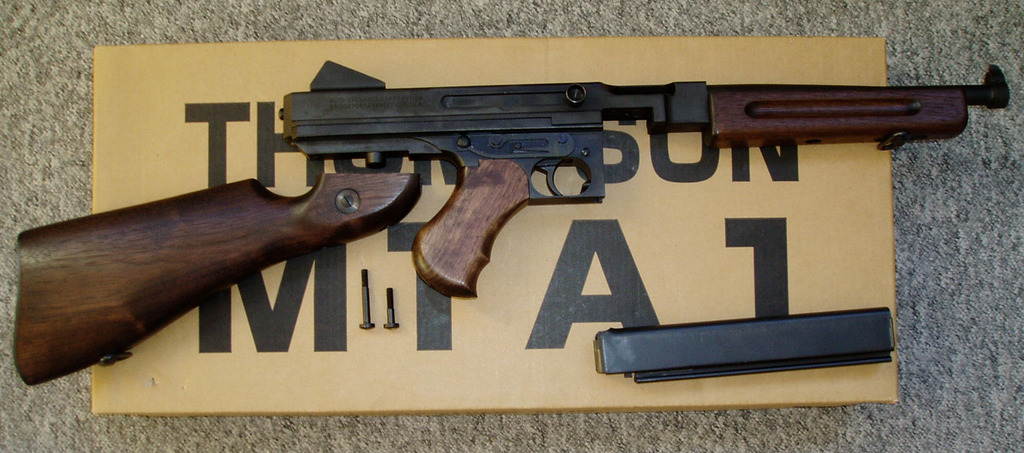 4. Markings
4. MarkingsThe CAW model should be a refreshed worked over re issue and they have made a nice job Marking look like this.
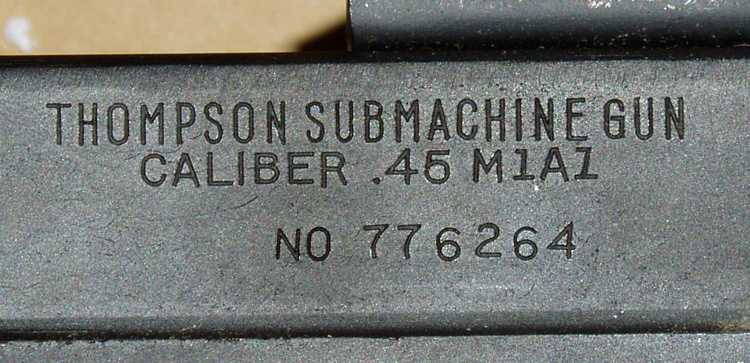
Receiver rear left
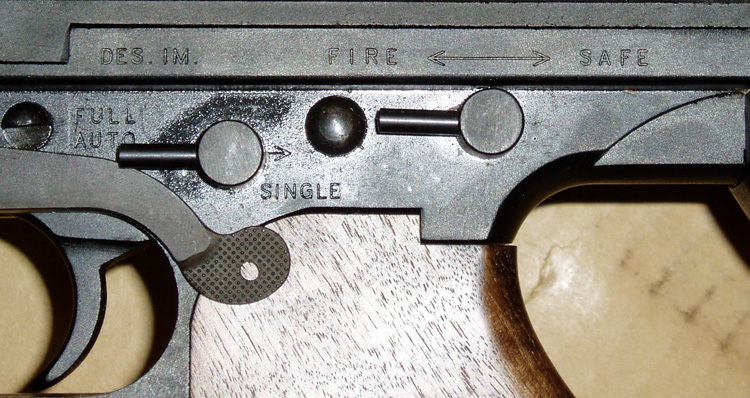
Safety & fire select

Receiver right front

Receiver right rear

Receiver top
I hope the pictures do the engraving justice. In my opinion the engravings are crisp and sharp and fully sufficient to replicate a real M1928M1A1.
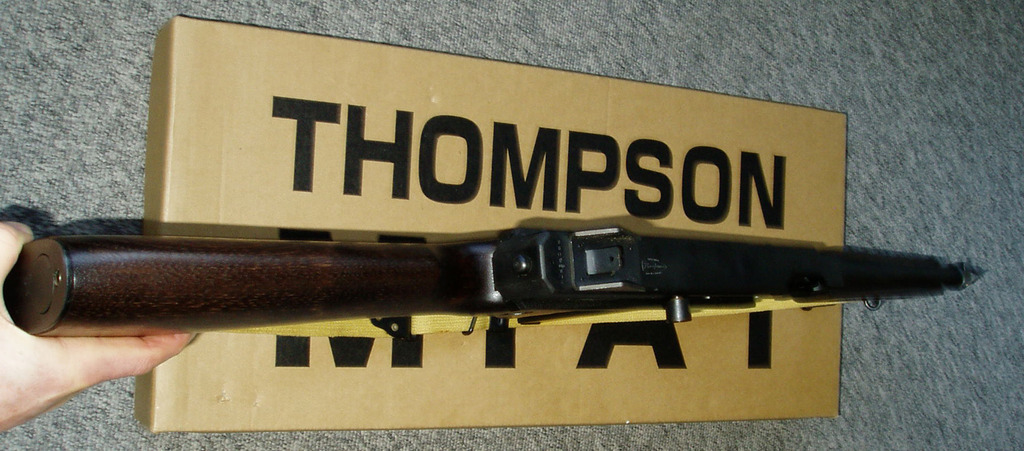 5. Weight
5. WeightA real steel Thompson weighs a little over 10lb or close to 5Kg The unloaded CAW model gun weighs 4100gr. Even at the slight over 4Kg the model feels really heavy, so complaining about the last 15% weight missing seem pointless - -this model truly leaves the impression of being HEAVY. The 4,1 Kg is the unloaded model, adding a full magazine will add some 0,7 Kg.
Enough of this bookkeeping – it is a metal, heavy weight model gun and it lives up to the description.
6. Strip down and assembly
Stripping of the CAW model goes just like the real thing.
• Remove the magazine and make sure the chamber is empty.
• With the receiver in forward position, place the gun “bottoms up”
• Press the knob on the lower rear edge of the
• Pull the trigger group rearwards
• Pull the trigger and slide all the way and remove the trigger group.
• Takeout block and remove receiver from receiver housing
• Inspect and clean chamber and detonator pin
Assemble the gun in reverse order.
I know the audio is Czech and low in the linked video,
https://www.youtube.com/watch?v=8YfFzJ8rWLwbut its short and in my opinion clearly shows how to do it.
For good and smooth operation and firing make sure to add proper lubrication to all moving parts.
As mentioned above the model comes with rear stock detached in the box. Mounting the stock requires a medium/large screwdriver (not supplied. There are 2 different screws (only difference is length) plug in the shortest in front and tighten both.

Do remember to tighten the screw connection reinforcing the stock. This is clearly a point where the reenactor will source an authentic Thompson screwdriver
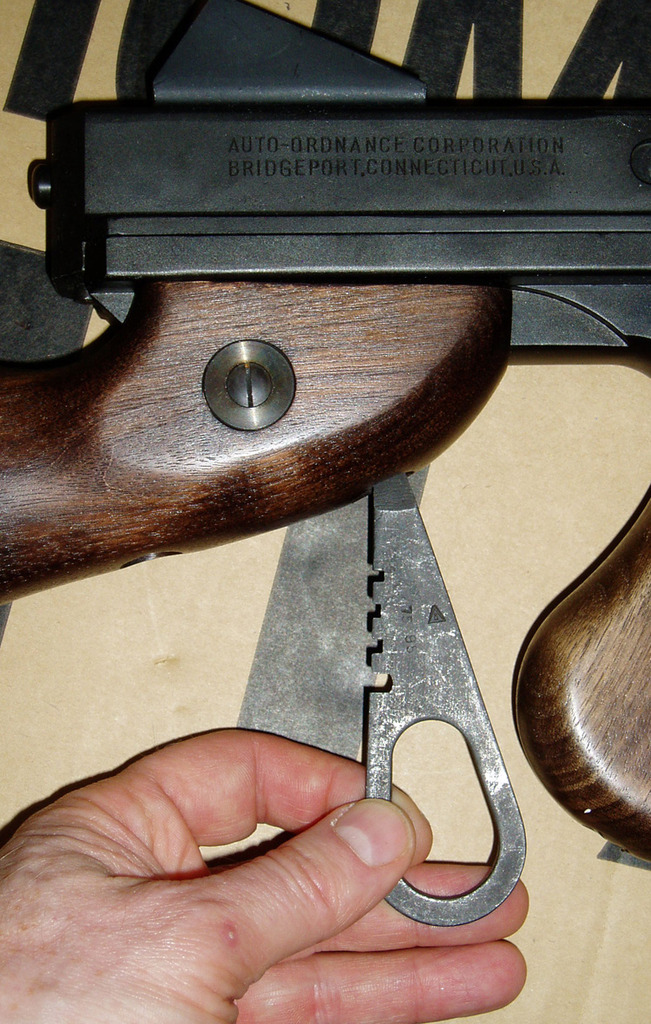
Should you choose to store the model gun in the original box you will have to mount the stock each time you take the model out.
That’s it.
7. Magazine & loadingThe magazine is as close to the real thing as you get. BUT I did get the chance to place the CAW next to a real Thompson magazine !

I have to admit that visually you do not see the difference (unless the 2 are next to each other) Functionally its fine. And yes the model accepts a “real steel” magazine – NB I have inly test fired with the CAW magazine.
Being a double stack loading is easy – just click in the cartridges and “shuffle in” the stick.
Note as we are here dealing with the M1928M1A1 model I can take 20rd magazines but it cannot take drum magazines.
8. Cartridges & fireAs I have understood the CAW M1928M1A1 should be able to use Hudson, MGC and naturally the original CAW.
The old Hudson and MGC are straight sided and for the sensitive reenactor just a bit simplistic. But they work. The new CAW, in my opinion, look like a hollow point – and again if you are hardcore reenactor maybe the Hudson/MGC appearance is preferable.

Yes they do look identical, but be careful. The 2 internal pistons have different length in the 2 designs, so I could fear that if you mix them up you could experience firing trouble.
The basic internal design is the same and so is loading – and straight forward. Insert the “rear piston” and lubricate the inner bore. Insert the cap and use the fine little tool to push the cap to the bottom. Fill in the piston with O-ring, screw on the front and use the thin end of the tool to push back the front piston. That’s it, regardless of the make of cartridge.
The models with only 5 cartridges, which is absolutely NOTHING for such an nice firing automatic ! I had been reassured that it would also fire MGC .45’s so I set off testing with the original CAW and a good handful of MGC’s cartridges.
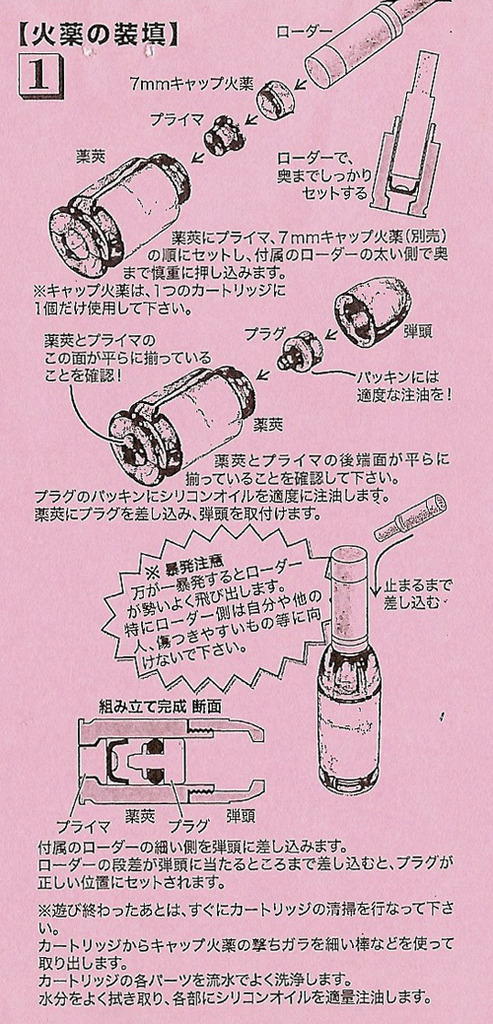
I did plan to fire the CAW’s in single mode, but honestly forgot, and by a firm grip with the trigger they were all gone with a roar. So did I switch it off auto mode when I had reloaded with MGC’s “Well to tell you the truth in all this excitement . . . “ I simply just had to feel and hear the 20 MGC’s firing and flying through the room.
So I would say that from a simple testing the CAW M1928M1A1 fires CAW and MGC cartridges equally well. Yes a limited number of Cartridges fired but all of them flawless on full auto.
9. ConclusionLet’s take it a bit in steps. The box is straight brown cardboard, in my opinion very loyal to the idea of the M1928M1A1 being a cost out compared to earlier M1921 and M1928. However the box cannot be used to store the assembled model. For me it’s OK but if storage is key, you could consider one of these Harley scabbard’s – and mount it in the wall just inside the door to the “man cave”
Instructions are sufficient for me, for a complete new beginner they might seem a bit basic. Anyway they do the job.
Finish. I find the matt blue finish of the gun parts very nice and very realistic. There might be those that argue it should have been a bit more shiny - but in my opinion this is a new model with finish like a new gun. Very Nice. Second the real wood stock and grip is just so nice, not complaining but almost too nice. What I mean is if the model is to do for wartime, cost out weapon - less finish on the real steel would not have surprised me, but here its rude to complain it just smooth and nice real wood.
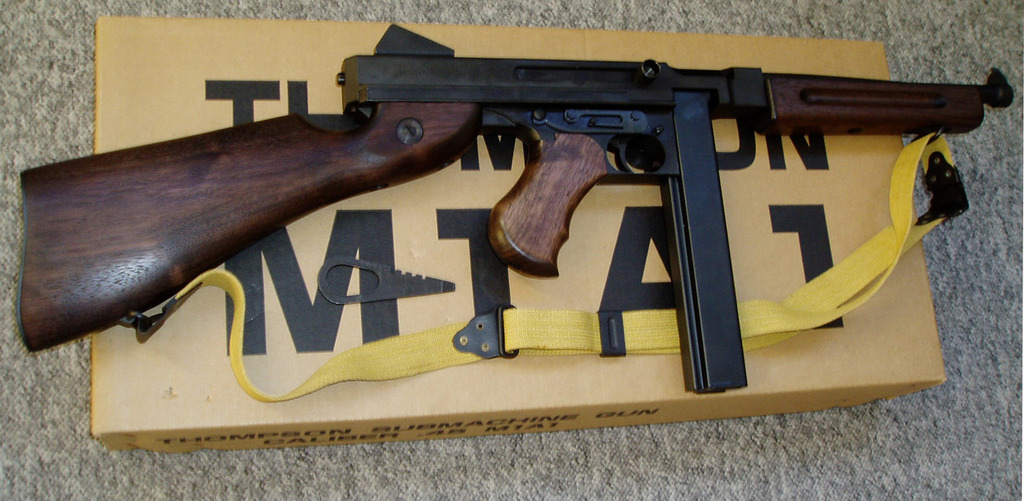
Despite the length difference real gun magazines seem to be an option. It’s possible the feed lips will need adjustments – I cannot say – but they fit in the magazine well and appear to reach appropriately in the model gun. Are somebody out there going to make some testing ??
I was really positive that the model takes the MGC cartridges so well, they are a true alternative. Next I felt a bit annoyed that internal parts are apparently alike but still so different that I could fear mixing them up will lead to firing trouble and if so a time consuming sorting operation. To consider before you clean everything in a big bucket !
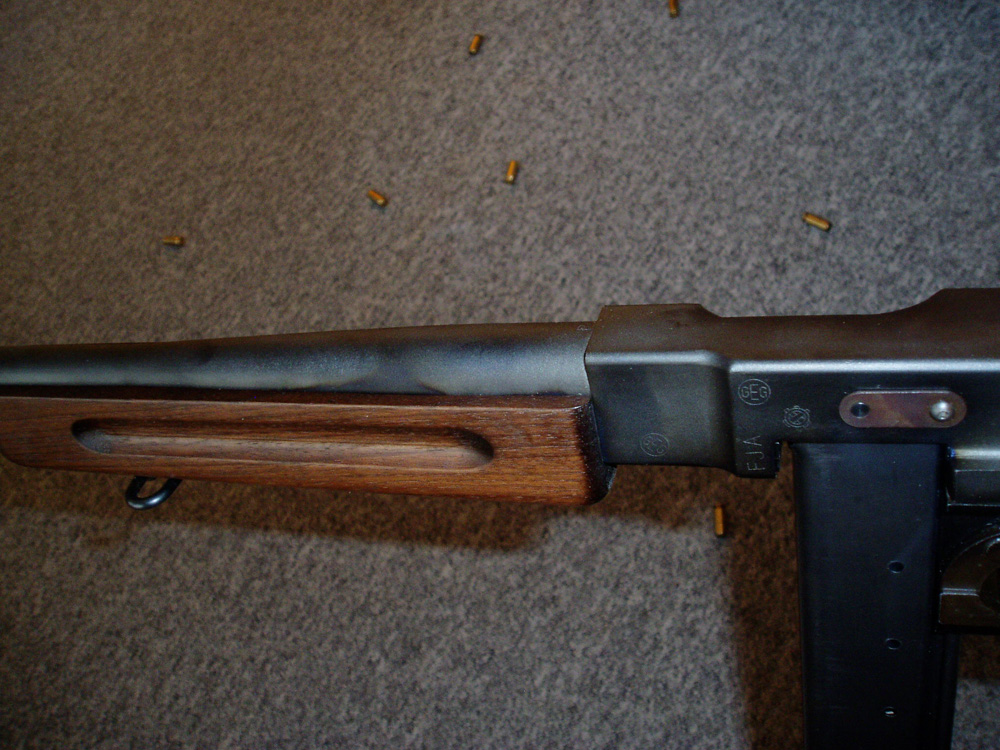
Weight yes I know that mathematically we are still almost 15% short. Come on, real wood, cold metal and heavy what more could you wish for ?
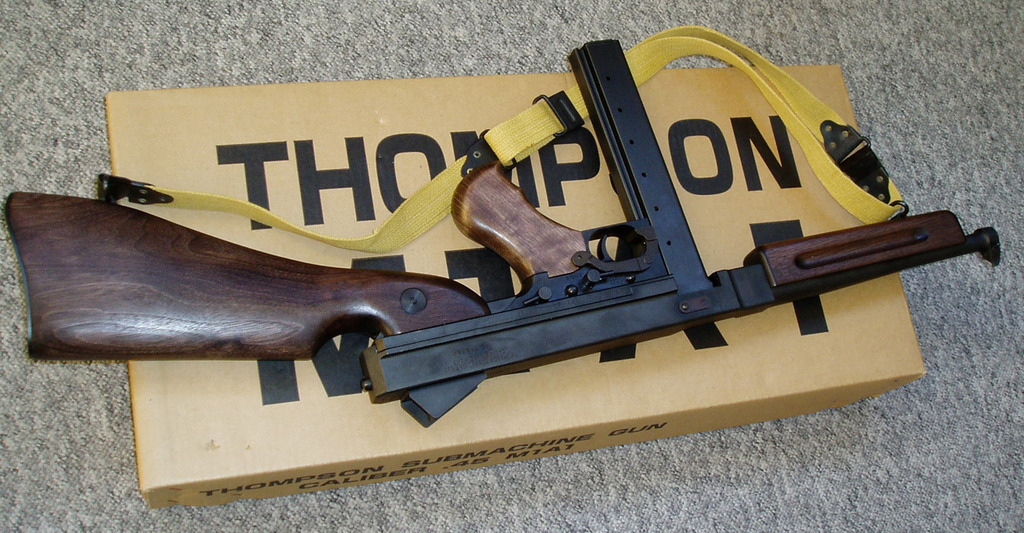
Handling the model can reveal a small wobbling originating from the lose fit between upper and lower receiver. I noticed it when handling it – but with the firing performance of this model you do not see, hear or feel anything else than spent cartridges flying around once it’s on full auto. Actually is blasting away, so hard that the pin in the front sight was shaken loose on my model after having fired the first 25 shots. No big fuzz, just put it back and give it a gentle strike with a hammer, and its ready to go.

Now is there absolutely nothing that could be better – ohh yes
1. 5 Cartridges is far too little, should be at least 30 !
2. Next – when in full auto 1 magazine empties fast 1 more, and 30 additional cartridges would be nice
3. If you choose to store in the original cardboard box toy will need one of these nice authentic Thompson
screwdrivers (they work just fine for the stock mounting)
4. While at the tools a model like this needs lubrications, so you’d better fine yourself one of the Thompson
oilers (that happen to fit into the compartment in the butt stock)
5. Oh and yes a sling
6. Last but not least storage, being the man cave, Harley holster or a canvas cover or ?
To get back to the serious part – it looks great, it feels heavy and it fires great.
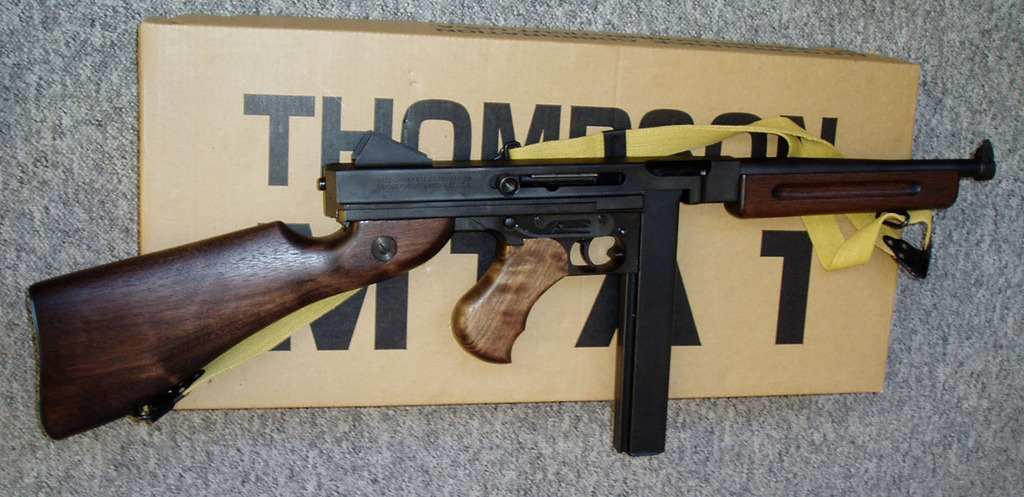
This review have now, with a good margin, passed 3000 words (with a big help from Wikipedia in the first chapter) and to put it short I could have done it in 3 words.
I LIKE IT
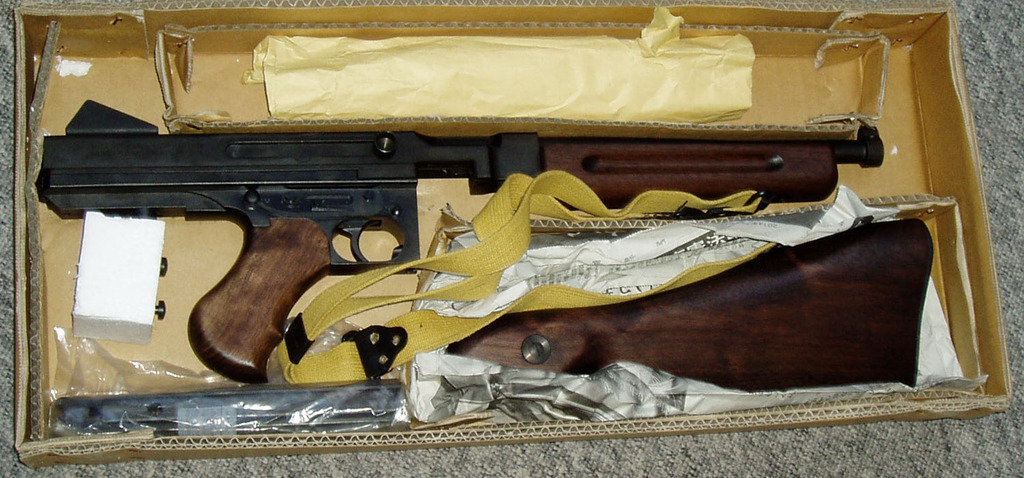
Over and out


